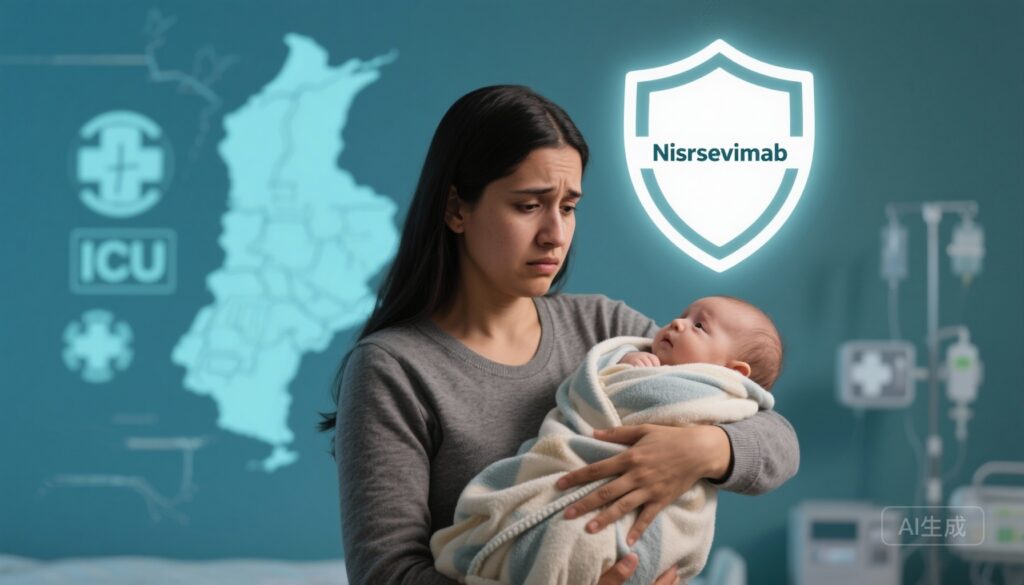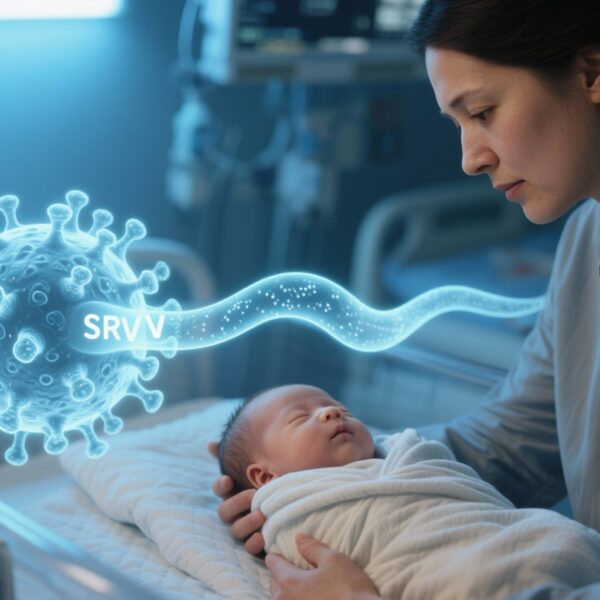Highlights
Key points
– Chile’s national rollout of nirsevimab (April–Sept 2024) was associated with a 76.4% reduction in RSV-related lower respiratory tract infection (LRTI) hospitalisations among infants.
– Effectiveness against RSV-related intensive care unit (ICU) admission was 84.9%; all-cause LRTI admissions fell by 66.5% and all-cause hospitalisations by 47.9%.
– Estimated impact: 30.05 averted RSV LRTI hospitalisations per 1000 immunised infants and a number needed to immunise (NNI) of 35 to prevent one RSV-related LRTI admission.
Background: RSV burden and prevention gaps
Respiratory syncytial virus (RSV) is a leading cause of acute lower respiratory tract infection in infants and young children worldwide and is a major driver of paediatric hospitalisation and intensive care admissions. Global estimates before widespread monoclonal antibody availability indicated substantial morbidity and mortality in infants, concentrated in the first year of life. Effective, seasonal prevention strategies for broad infant populations have been limited historically to passive immunoprophylaxis for high‑risk infants (e.g., palivizumab) or maternal vaccination approaches that have variable uptake and coverage.
Nirsevimab is a long‑acting monoclonal antibody directed against the RSV fusion protein, designed to provide single‑dose seasonal protection for all infants. After regulatory approvals in several jurisdictions, countries are adopting different delivery strategies (targeted high‑risk vs universal seasonal programmes). Chile implemented the first universal, birth‑cohort–based national programme in the southern hemisphere in 2024. Evaluating real‑world effectiveness and public health impact is critical to guide other national immunisation policies.
Study design and methods (NIRSE‑CL)
This retrospective, observational study used consolidated national registries from Chile to evaluate the effectiveness and impact of nirsevimab during the 2024 RSV season. Roll‑out targeted two cohorts: a seasonal newborn cohort (infants born 1 April–30 Sept 2024) and a catch‑up cohort (infants born 1 Oct 2023–31 Mar 2024). Immunisation occurred during the nationwide campaign (1 Apr–30 Sept 2024).
Primary endpoint: RSV‑related LRTI hospitalisation identified via a set of ICD‑10 codes that were selected based on historical sentinel surveillance from 10 hospitals with universal RSV testing for LRTI admissions (years 2019, 2022, and 2023).
Secondary endpoints: RSV‑related ICU admission, all‑cause LRTI hospitalisation, and all‑cause hospitalisation occurring ≥7 days after birth.
Analysis: Study population included 154,173 infants with determinable immunisation status. Effectiveness was estimated with stratified Cox proportional hazards models adjusted for age, sex, geographical area, and gestational age weeks; effectiveness = (1 − hazard ratio) × 100. Impact was estimated against a counterfactual no‑nirsevimab scenario to compute averted cases, relative reduction, and the number needed to immunise.
Key findings
Population and uptake
– 157,709 infants were initially extracted; after exclusions for missing/corrupt records and indeterminate immunisation status, 154,173 infants remained in the primary analysis. Median age was 6.27 months (IQR 3.20–9.17); sex distribution was balanced.
– 145,087 infants received nirsevimab by the end of the roll‑out (72,246 in the catch‑up cohort; 72,841 in the seasonal cohort), indicating very high uptake among eligible cohorts.
Primary effectiveness outcomes
– Combined effectiveness (catch‑up and seasonal cohorts) against RSV‑related LRTI hospitalisation: 76.41% (95% CI 72.57–79.72).
– Against RSV‑related ICU admission: 84.94% (95% CI 79.47–88.95).
Secondary and broader outcomes
– All‑cause LRTI hospitalisation: effectiveness 66.50% (95% CI 61.97–70.50).
– All‑cause hospitalisation (≥7 days after birth): effectiveness 47.90% (95% CI 44.35–51.21).
Impact metrics
– Relative reduction in RSV‑related LRTI hospitalisations estimated at 77.46% compared with a no‑nirsevimab counterfactual.
– Estimated 30.05 averted RSV LRTI hospitalisations per 1000 infants immunised.
– Number needed to immunise (NNI) to prevent one RSV‑related LRTI hospitalisation: 35.
Safety
– The registry‑based effectiveness study did not report individual adverse event data. Safety conclusions therefore rely on prior clinical trial data and post‑licensure surveillance; this study does not replace the need for ongoing safety monitoring in real‑world use.
Interpretation and clinical significance
The NIRSE‑CL results provide robust real‑world evidence that a universal, birth‑cohort strategy using a single dose of nirsevimab can substantially reduce RSV‑related hospitalisation and severe disease requiring ICU care among infants. The magnitude of effect observed (≈76% reduction in RSV LRTI hospitalisations and ≈85% reduction in ICU admissions) aligns with expectations based on the antibody’s neutralising activity and single‑season protective design.
The observed reduction in all‑cause LRTI admissions (≈66%) and all‑cause hospitalisations (≈48%) suggests that preventing RSV has downstream benefits for overall infant respiratory health and healthcare utilisation during the RSV season. The NNI of 35 compares favourably with many other preventive interventions in paediatrics and supports strong public‑health value when weighed against hospitalisation costs and ICU resource use.
Strengths
– Large, nationally consolidated dataset with high uptake and near‑complete cohort coverage.
– Use of a pre‑specified, sentinel‑validated set of ICD‑10 codes to capture RSV‑related admissions increases case specificity compared with relying on unspecific respiratory codes alone.
– Adjusted time‑to‑event analysis (stratified Cox model) controlled for key confounders (age, sex, geography, gestational age) and allowed estimation of vaccine‑like effectiveness in routine practice.
Limitations and caveats
– Observational design: although analyses adjusted for major covariates, residual confounding (e.g., differences in healthcare seeking, socioeconomic status, or unmeasured comorbidities) may influence effect estimates compared with randomized trials.
– Case ascertainment relies on ICD‑10 proxies validated against sentinel hospitals with universal testing; misclassification remains possible, particularly outside sentinel sites or in milder LRTIs not leading to testing.
– Lack of individual‑level virological confirmation in the national dataset limits pathogen‑specific attribution for every hospitalisation event.
– Safety data were not captured in this effectiveness study; continued pharmacovigilance is necessary to detect rare or unexpected adverse events in population use.
– Chile’s healthcare system, seasonality patterns, and campaign timing may differ from other settings; direct extrapolation requires contextual adaptation.
Mechanistic plausibility and comparison with prior evidence
Nirsevimab targets the RSV fusion (F) protein with an extended half‑life, allowing single‑dose protection across the typical RSV season at birth. Clinical development programmes previously demonstrated protective efficacy in trial settings for healthy term and late‑preterm infants. The NIRSE‑CL real‑world effectiveness estimates concord with clinical trial efficacy signals, and the stronger effect against ICU admissions is biologically plausible given prevention of severe lower respiratory tract involvement.
Policy and practice implications
– The Chilean experience supports consideration of universal seasonal infant immunisation with nirsevimab as a strategy to reduce RSV morbidity and healthcare burden, particularly in countries with predictable seasonal RSV peaks.
– Health economic assessments should incorporate the observed reductions in hospital and ICU admissions, direct medical cost savings, and indirect benefits (reduced parental work loss, outpatient visits) to inform reimbursement and sustainability decisions.
– Implementation requires robust supply chains, clear birth‑cohort timing, provider education, and integration with existing neonatal and immunisation services to achieve high coverage.
– Ongoing surveillance linking clinical outcomes, virology, and safety signals will be essential to monitor durability, variant impact, and rare safety events.
Research gaps and next steps
– Comparative cost‑effectiveness studies across different delivery strategies (universal vs targeted vs maternal immunisation) in varied epidemiological contexts are needed.
– Longitudinal monitoring to determine whether single‑season protection influences subsequent RSV season timing, age shift, or burden in older infants and toddlers.
– Integration of virological surveillance with outcomes data will strengthen pathogen‑specific attribution and allow early detection of potential escape variants.
Conclusion
Chile’s national rollout of nirsevimab during the 2024 season was associated with substantial reductions in RSV‑related hospitalisations and ICU admissions in infants, with broader decreases in LRTI and all‑cause hospitalisations. These real‑world effectiveness and impact data provide supportive evidence for policymakers considering infant monoclonal antibody programmes and underscore the need for continued surveillance, economic evaluation, and context‑specific implementation planning.
Funding and clinicaltrials.gov
The study was funded by Instituto Sistemas Complejos de Ingeniería and the Ministry of Health of Chile. The trial was registered at ClinicalTrials.gov, NCT06511687 (completed).
References
1) Torres JP, Sauré D, Goic M, Thraves C, Pacheco J, Burgos J, Trigo N, Del Solar F, Neira I, Díaz G, O’Ryan M, Basso LJ. Effectiveness and impact of nirsevimab in Chile during the first season of a national immunisation strategy against RSV (NIRSE‑CL): a retrospective observational study. Lancet Infect Dis. 2025 Nov;25(11):1189‑1198. doi:10.1016/S1473‑3099(25)00233‑6.
2) Shi T, McAllister DA, O’Brien KL, et al. Global, regional, and national disease burden estimates of acute lower respiratory infections due to respiratory syncytial virus in young children in 2015: a systematic review and modelling study. Lancet. 2017;390(10098):946‑958. doi:10.1016/S0140‑6736(17)30938‑8.
3) Centers for Disease Control and Prevention (CDC). Respiratory Syncytial Virus (RSV) and Beyfortus (nirsevimab‑bvz). CDC website. Accessed 2024. https://www.cdc.gov/rsv/clinical/beyfortus.html
(Readers are encouraged to consult the full Lancet Infectious Diseases paper for detailed methods, supplementary analyses, and country‑specific implementation details.)



